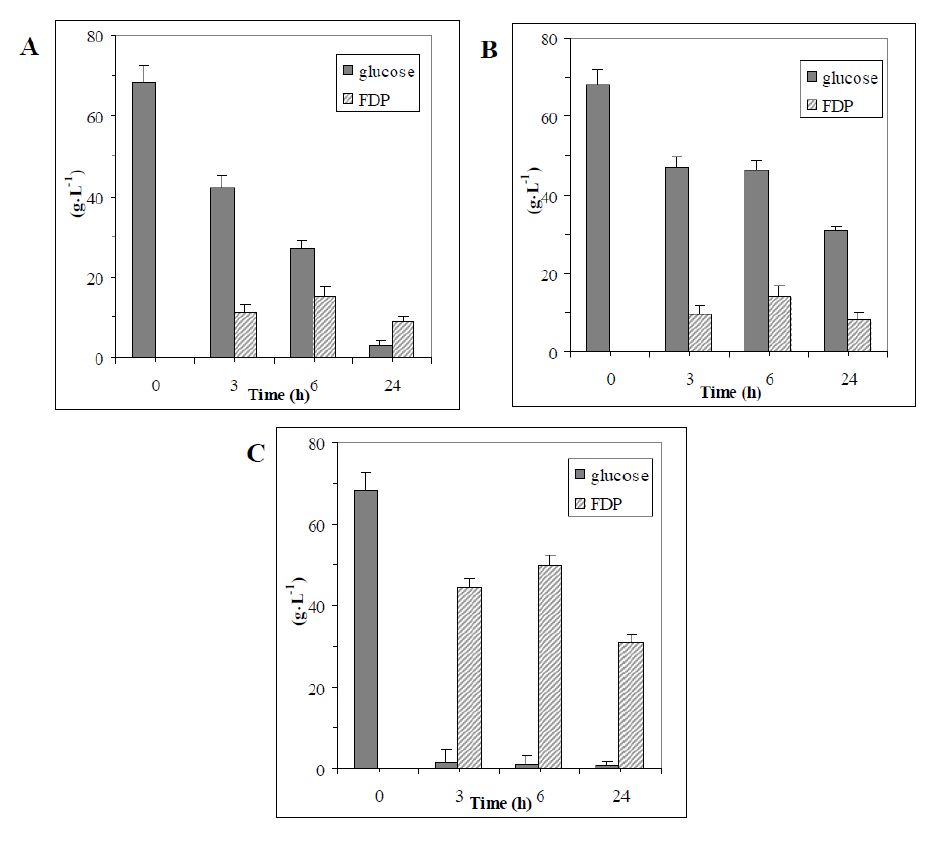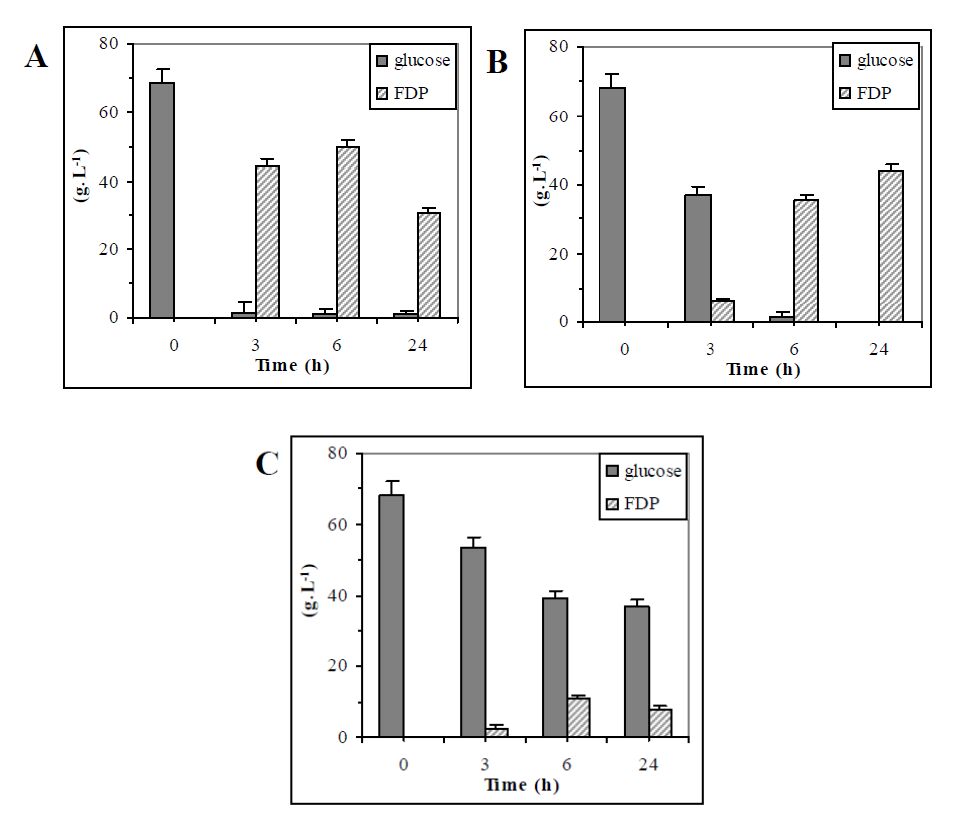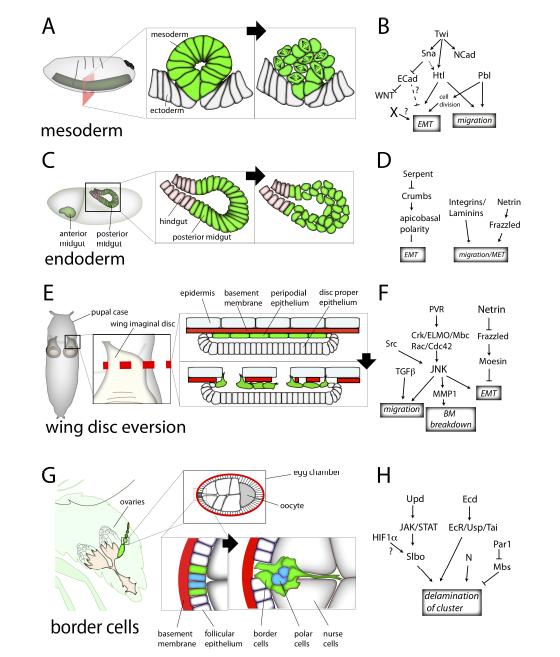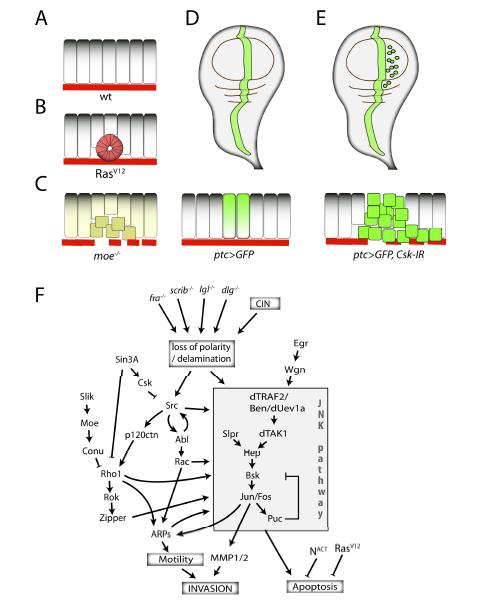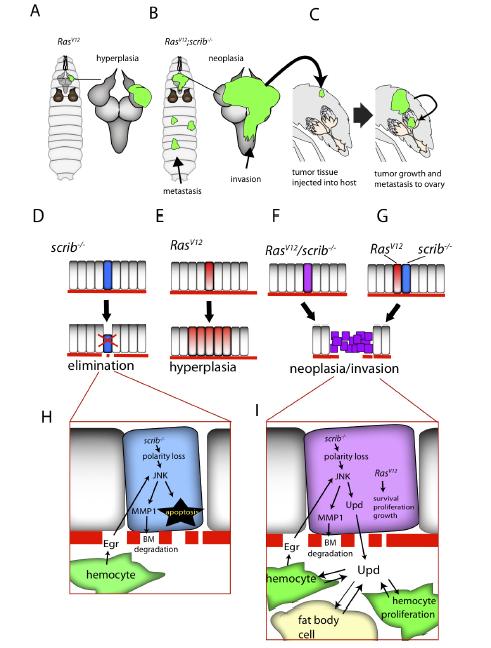1. Introduction
In the living cells, the catabolism of glucose involves several sugar phosphates as intermediate products, among which fructose 1,6-diphosphate (FdP) has an important role in many other metabolic pathways. This compound enhances carbohydrate utilization by stimulating glycolysis and, simultaneously, inhibiting gluconeogenesis [1]. During the last two decades FdP salts have been used in several clinical and therapeutic applications, as the prevention of myocardial ischemia [2]. It is reported that FdP can protect against neuronal damage induced by febrile convulsions [3,4] and to have a salutary effect in endotoxin shock and sepsis . Based on its importance in the pharmaceutical field, there is an increasing interest in the development of a FdP production process suitable for industrial implementation. The biotechnological production of FdP requires a simple and low-cost process to obtain high concentrations of the biocatalyst (biomass, cell extract or purified enzymes) able to convert low cost substrates (if possible) into product of interest. One of the methods traditionally utilized for producing FdP is based on the enzymatic phosphorylation of glucose with inorganic phosphate, catalysed by exhausted Saccharomyces carlsbergensis cells, recovered from brewing wastes [5,6]. This raw material is inexpensive but has the drawback of being an heterogeneous mixture of non characterized yeast cells, in various metabolic states, which is an obstacle to FDA approval of the FdP manufacturing process. Compagno et al. demonstrated that an efficient bioconversion of glucose into FdP could be achieved using fed-batch grown Saccharomyces cerevisiae cells, opportunely permeabilized with toluene. Testing different concentrations of biocatalyst and substrates in the medium, they obtained an efficient bioconversion corresponding to 70% of the theoretical value. The same authors have explored the possibility of obtaining FdP from cheaper carbohydrate sources, such as molasses [7] or milk whey [8]. In the latter case, it was used a genetically engineered S. cerevisiae strain, able to degrade lactose contained in whey. In these papers the goal was to improve the bioconversion yield on different substrates, without considering the fermentation process needed to achieve high concentrations of biocatalyst, necessary for the bioconversion itself. In the past, it was evaluated the possibility of producing FdP using cell extracts or semi-purified enzymatic pools in place of whole cells. Interestingly, Nakajima et al. (1991) proposed a new FdP production method in which FdP is synthetized from glucose by three enzymatic step catalysed by glucokinase, phosphoglucose isomerase and phosphofructokinase coupled with an enzymatic ATP regeneration reaction catalyzed by acetate kinase. Based on this method, FdP was produced in a batch reactor and a semi-batch reactor, using purified enzymes and a cell extract containing these enzymes [9]. However, the experimental results of the FdP yield approached the theoretic predictions. The performances of the enzymatic systems were also studied in continuous mode with an ultrafiltration hollow fiber reactor [10]. The predictions of the developed model were, to a great extent, confirmed by experimental results [9]. In this work, we tried to develop an alternative production process of FdP, using as catalyst a new single yeast strain isolated from brewing, in agreement with the European and Food and Drug Administration (FDA) regulatory provisions.
2. Materials and Methods
2.1. Materials
Yeast extract, peptone and bacteriological agar were purchased by Oxoid (Basingstoke, England). All the other chemicals needed to prepare media were provided by Sigma-Aldrich (Milan, Italy). Toluene, ethanol and triton-X used for cell permeabilization was purchased by Carlo Erba (Rodano, Italia).
2.2. Yeast strain and maintenance
Saccharomyces pastorianus DSM 6581 was obtained by the Deutsche Sam mLung von Mikroorganismen und Zellkulturen Gmbh (Braunschweig, Germany), in form of agar pure culture. This culture was re-vitalized into YEPG (yeast extract 10 g·L-1, peptone 20 g·L-1 and glucose 20 g·L-1) medium, then petri dishes were inoculated and successively incubated at 30 °C. The microorganism was maintained on YEPG agar at 4 °C and as suspended culture (stabs) at -80 °C using glycerol (20% v/v) as cryoprotectant. These stabs were used for inoculum preparation before the fermentations.
2.3. Media
The medium used for inoculum and batch fermentations was a semi-defined (SDM) medium containing: glucose 20 g·L-1, yeast extract 10 g·L-1, KH2PO4 5 g·L-1, (NH4)2SO4 5 g·L-1, MgSO4 1 g·L-1. Glucose and KH2PO4 were added to the sterilized medium as concentrated solution after sterilization by filtration with 0.22 μm membranes (Millipore, France). The ph was adjusted to 5.5 with NaOH 2M. Batch fermentation experiments were performed decreasing yeast extract concentration from 10 to 2.5 g·L-1. In fed-batch fermentations a concentrated nutrient solution containing glucose 200 g·L-1, yeast extract 10 g·L-1, KH2PO4 10 g·L-1, (NH4)2SO4 10 g·L-1, MgSO4 10 g·L-1 was fed into bioreactor according to predefined profiles. In the MF fermentations, besides this solution, a solution containing MgSO4 10 g·L-1 was fed to maintain a constant volume in the fermenter.
2.4. Fermenters description
The fermenters used for this work were Biostat Q, Biostat CT and Biostat C (Braun Biotech, Germany) with a working volume of 0.7 L, 2 L and 15 L, respectively. Except the first, bioreactors were in situ sterilizable. They were equipped with pH, pO2 (Mettler Toledo, Switzerland) and temperature probes. The pO2 control was possible by varying agitation speed (10-2000 rpm) and airflow and probe calibration was performed by sparging air. ph was controlled with automatic addition of 20% v/v NH4Oh or 20% v/v H2SO4. They were connected to a DCU (Digital Control Unit) to set different parameters as pH, pO2, agitation speed (rpm), aeration (L·min-1) and temperature (°C). Moreover, the fermenters were connected to a PC and remotely controlled by the MFCS-win software. The systems were provided with four peristaltic pumps for the addition of alkali, acid and nutrients. The Biostat CT and Biostat C, during this research work, were modified by the insertion of two microfiltration modules [11] installed inside the vessel and connected to a peristaltic pump (model 323, Watson Marlow, United Kingdom). Microfiltration modules used to perform Biostat C experiment were assembled similarly to the ones used in the 2 L fermenter [12]. The whole device was allocated in the fermenter and connected to a peristaltic pump being part of a pumping system, in situ sterilizable by steam, also able to operate automatic back-flushings [13]. The activation of the peristaltic pump allowed the removal of the exhaust medium, by generating a transmembrane flux from 1 to 0.5 L·h-1.
2.5. Fermentation Experiments
2.5.1. Batch fermentations
For inoculum preparation, stabs were inoculated into shake flasks (1 L for Biostat CT or 2 L for Biostat C) containing 200 mL (Biostat CT) or 400 mL (Biostat C) of SDM; the inoculum was grown for 12 h in a rotary shaker (HT Aquatron; Infors, Switzerland) at 30 °C and 250 rpm. Batch experiments were first carried out in a 1 L reactor described above, like all the other fermentation experiments, were inoculated from seed cultures so that the starting absorbance (600 nm) value was kept between 0.08 and 0.10. In all experiments, temperature and ph were kept constant at 30 °C and 5.5, respectively. Experiments were then run on the 2L using always the standard medium (SDM) and setting the temperature at 37 °C.
2.5.2. Fed-batch fermentations
Fed-batch experiments were carried out both on 2 L and, in scale up procedure, on the 14 L fermenter. Fed-batch experiments on Biostat CT and Biostat C started with 8 h of batch growth, the process continued with a fed-batch phase during which an exponential feeding strategy was initially designed according to the following equation:
|
$F(t)=\frac{{{X}_{0}}{{V}_{0}}\mu }{{{Y}_{{}^{X}\!\!\diagup\!\!{}_{S}\;}}({{S}_{in}}-S)}{{e}^{\mu t}} \left( eq.1 \right)$
|
where: X
0 is the initial biomass concentration (g·L
-1), V
0 is the starting volume (L), μ is the specific growth rate (h
-1), Y
x/s is the yield coefficient of the biomass on the substrate, S
in is the glucose concentration of the feeding solution (g·L
-1) and S is the culture glucose concentration (g·L
-1) and t is the time after starting the feed (h). This exponential profile was calculated and regulated via MFCS-win software.
For the duration of all cultivations, 5 mL samples were withdrawn from the reactors at regular time intervals for the determination of substrates and extracellular metabolites as ethanol.
2.5.3. Microfiltration fermentations
Microfiltration experiments were carried out on the 2.5 L. In these experiments, precultures were obtained inoculating 1 L shake flasks for 12 h. The starting medium volume was 1.8 L and airflow was set initially at 1.8 L·min-1 (1vvm) and then increased to 3.0 L·min-1 (1.7 vvm). pO2 value was set at 20% and maintained stable by activating a stirring cascade (250-1250rpm) and then performing O2 enrichment.
Microfiltration (MF) experiments were performed starting with a batch mode, switching after 8 h in fed-batch and later after 5 h in a MF mode: the experiments lasted 40-45 h [14]. The duration of each phase was settled by evaluation of glucose consumption and its effect on growth rates. To keep constant the volume inside the fermenter, the level controller was also activated to allow the addition of saline solution. During fed-batch and MF phases a concentrated feeding solution was added according to equation 1. Two different concentrated feeding solutions were used. During the fed-batch phase, it contained 200 g·L-1 of glucose, 10 g·L-1 of yeast extract and a 2-fold increased salt concentration, while during the MF phase it contained 200 g·L-1 of glucose, 10 g·L-1 of yeast extract and only MgSO4 as salt in a concentration of 10 g·L-1. Feeding strategy was designed in order to maintain glucose concentration above 1 g·L-1 to activate fermentative metabolism.
During the whole experiment about 10 L of exhaust medium were exchanged. A 100-fold diluted antifoam solution (Antifoam 204, Sigma) was added to culture vessel when necessary.
2.6. Bioconversion experiments
Fermentation broth was harvested and centrifuged at 5000 g at 4 °C for 30 min (Avanti J26 XP, Beckman CoulterTM) and biomass was stored at 4 °C, maximum for a week; afterwards it was utilized as biocatalyst in the bioconversion to FdP. Yeast cells were re-suspended in 50 mL of bioconversion medium (378 mM glucose, 176 mM Na2 HPO4 and 32 mM H3PO4 85%) in shake flasks (250 mL) to obtain different cell concentrations (350, 250 and 150 g wet weight per liter). Permeabilization of cell membrane was obtained by the addition of 10% v/v toluene and vigorous shaking of the suspension. Bioconversion experiments were performed varying the molar ratio between the substrates in the medium (glucose and phosphate). The flasks were incubated in a rotary shaker at 250 rpm and 30 or 37 °C and were monitorated following the kinetics of glucose consumption and FdP production in the medium.
2.7. Analytical methods
Cell growth was followed during experiments by measuring absorbance at 600nm on a Beckman DU 800 Spectrophotometer (Milan, Italy). Samples collected every hour were spinned down in an AVANTI® J-26XP centrifuge (Beckman CoulterTM) at 2000g; wet weight was measured after centrifugation and washing in saline solution (0.9% w/v NaCl). The cell dry weight was measured after heating the washed pellet overnight (16-18 h) at 85 °C until reaching constant weight. The supernatant (1 mL) was ultrafiltered on centricon tubes 10 kDa cut-off, (Millipore, France) at 5000 g to prepare samples for analytical quantification of glucose consumed and ethanol produced.The concentrations of these metabolites were measured through HPAEC-PAD analysis performed with a Dionex chromatographer (model ICS 3000) using a CarboPac MA1 column coupled with a pulsed amperometric detector (PAD). The separation of components was obtained by isocratic elution with NaOH 320 mM and a flow-rate at 0.4 mL·min-1. The quantitative analysis of glucose consumed and FdP produced during the bioconversions was performed collecting samples every hour; the ultrafiltered supernatants were analyzed using the same ionic chromatographer, equipped with a CarboPac PA100 column. The separations of components was performed by using a binary gradient elution with NaOH 160 mM and sodium acetate 400 mM and flow rate at 1 mL·min-1.
3. Results
3.1. Batch experiments
Batch experiments were performed to evaluate the influence of complex components on both growth rate and yield coefficient. In the attempt of containing fermentation costs, we evaluated media based on decreasing amount of yeast extract. Figure 1 reports the growth curve for S. pastorianus DSM 6581 with 10 g·L-1 [3], 5 g·L-1 and 2.5 g·L-1 of yeast extract. It can be seen that the decrease of complex nutrient does not significantly affect the final yield. In fact, cell density was equal to 11.9 gcdw·L-1, 9.45 gcdw·L-1 and 7.2 gcdw·L-1, respectively. Growth curves, reported in Figure 1,showed that during the first phase (8 h) the specific growth rates were similar for each experiment: 0.50 h-1; 0.46 h-1; 0.44 h-1, despite a certain improvement of density for the higher concentrations. Figure 2 shows a typical time course of S. pastorianus DSM 6581 in a 2 L fermenter in SDM with 2.5 g·L-1 of yeast extract, with respectively glucose consumption and ethanol production; it can be clearly seen the approach of the stationary phase concomitantly to the depletion of glucose in the medium. A typical diauxic growth follows on ethanol as expected.
3.2. High cell density cultivation (HCDC)
3.2.1. Fed-batch experiments
A fed-batch process was developed in order to provide a steady supply of glucose and yeast extract thus prolonging growth phases. In all experiments performed, the medium was fed after 8 h of growth, accordingly to the evaluated consumption rates in the batch experiments. Different feeding strategies were tested varying the C/N ratio in the media (data not shown). The best results were obtained maintaining 20:1 the ratio between glucose and yeast extract in the concentrated solution. The quantities used proved sufficient to maintain a residual glucose concentration in the reactor below 0.9 g·L-1. During 80 h cultivation, about 200 g of glucose and 10 g of yeast extract were fed with a rate ranging from 0.5 g·L-1·h-1 up to 4.0 g·L-1·h-1 of glucose. As a result, the specific growth rate decreased after the exponential phase from 0.15 to a minimum of 0.01 h-1; cells averagely reached a final concentration of 58 gcdw·L-1. The final yield (Yx/s) of biomass obtained in fed-batch fermentations on 2 L bioreactor was 0.51 gcdw· gs-1. Table 1 outlined results obtained.
Table 1. Results of averaged dry weight concentration, growth rates, yield coefficients and productivities during at least 3 experiments of each fermentation.
|
Batch |
Fed-bach (2L) |
Fed-bach (22L) |
Microfiltration (2L) |
| cell dry weight (g·L-1) |
7.2 ± 0.1 |
58.0 ± 1.7 |
51.0 ± 2.0 |
70.0 ± 4.2 |
| YXS1 (gcdw·gs1-1) |
0.14 |
0.51 |
0.55 |
0.19 |
| YXS2 (gcdw·gs2-1) |
0.5 |
0 |
0 |
0 |
| YPX (gP·gS2-1) |
0.44 |
0 |
0 |
– |
| Φ (gcdw·L-1·h-1) |
0.3 |
0.65 |
0.81 |
1.78 |
| μ (h-1) |
0.5 |
0.04 |
0.06 |
0.1 |
During this research, we attempted to a first scale up of the process increasing the culture volume 8-fold (from 1.8 L to 14 L). The nutrient feeding rate for the 14L fed-batch experiment was based on 1.8 L fermenter studies. A maximum biomass concentration of 51 gcdw·L-1 was reached in a process lasting about 63 h. The averaged results obtained on two different scale are compared in terms of yield and productivity in Table 1.
3.2.2. Microfiltration experiments
A fermentation strategy based on in situ microfiltration was applied in order to improve biomass production by removing the exhaust medium and thus the ethanol produced during growth [12]. The reduction of ethanol concentration in the fermentation vessel represents a way to limit inhibition and thus to improve final biomass yield and productivity [15].
Data concerning fermentation parameters as characteristic growth rate, yield, productivities are summarized in Table 1,while the growth curves of different fermentation are comparable in Figure 3. In microfiltration experiments we obtained a final biomass concentration of 70 ± 1 gcdw·L-1 in 40 hours of process, with a final yield of 0.19 gcdwּgs-1 (Yx/s).
The medium exchange rate decreased gradually with time from approximatively 21.4 L·m-2·h-1 to 7.1 L·m-2·h-1 at the end of the experiment because of membrane fouling due to transmembrane pressure difference and adhesion ability typical of this microorganism.
3.3. Bioconversion experiments
The second part of this work regarded the setup of procedures to convert glucose into FdP, possibly applicable on industrial scale, using the catalyst recovered from fermentation experiments.
In order to reach this target, several bioconversion experiments have been made modifying various parameters and using different permeabilization methods. Firstly, the influence of different glucose: phosphate molar ratios was evaluated. Therefore, we performed bioconversion experiments where the catalyst was resuspended in a medium containing a glucose: phosphate ratio of 1:2, 1:1, 2:1 respectively (Figure 4). The biotransformation experiments were carried out for 24 h at 37 °C. During bioconversion, 350 gcww·L-1 of catalyst have been permeabilized with a toluene concentration of 10% v/v [16]. Maximum of concentration and product yield were observed after 6 h of bioconversion for all experiments; FdP concentrations were 15.0 g·L-1, 14.2 g·L-1 and 49.8 g·L-1, respectively, as shown in Figure 4. In order to investigate on the effect of different biocatalyst concentrations, batch bioconversions were performed utilizing 350, 250 and 150 gcww·L-1, in the same conditions used in the previous experiments. The experiments utilizing the intermediate concentration of catalyst gave a final value of FdP of 44.1 g·L-1 at the 24th hour of bioconversion, comparable with one obtained in 6 h of biotransformation executed with 350 gcww·L-1, but with a different kinetic trend, as shown in Figure 5a and 5b. Figure 5c shows the results obtained with 150 gcww·L-1. The FdP maximum concentration is very modest (10.7 g·L-1) and glucose complete depletion was never achieved.
To test new permeabilization methods, we evaluated the effect of different chemicals and physical parameters, on the activity of the biocatalyst. All the experiments were performed with a molar ratio glucose/phosphate of 2:1 and with 350 gcww·L-1 of catalyst. As we can see from Table 2,differently to the other compounds, only the experiments performed with Triton X-100, as permeabilization agent, gave an FdP concentration comparable to the one obtained with the experiments that used toluene as permeabilization agent (56.3 g·L-1).
Table 2. Experiments of permeabilization with heat and solvent treatment.
| Permeabilization methods |
Temperature (°C) |
Glucose:phosphate Molar ratio |
FDP (g·L-1) |
Max Yield (%) |
FDP (g·L-1) |
Final Yield (%) |
| Heat treatment for cells permeabilization |
| 42°C for 1h before bioconversion |
37 |
2:1 |
n.d |
– |
– |
– |
| 37°C for 1h before bioconversion |
37 |
2:1 |
n.d |
– |
– |
– |
| Solvent treatment before bioconversion |
| 10% v/v toluene before bioconversion |
37 |
2:1 |
12 |
12.8 |
4.9 |
3.6 |
| 20% v/v ethanol before bioconversion |
37 |
2:1 |
1.9 |
22.8 |
1.6 |
5.7 |
| 1% triton-X before bioconversion |
37 |
2:1 |
56.3 |
80 |
1 |
0 |
| 10% v/v toluene during bioconversion |
37 |
2:1 |
49.8 |
35.4 |
30.9 |
21.9 |
| 10% v/v toluene during bioconversion |
37 |
1:1 |
14.2 |
30.7 |
8.3 |
10.5 |
| 10% v/v toluene during bioconversion |
37 |
1:2 |
15.2 |
16.1 |
8.7 |
6.4 |
| 10% v/v toluene during bioconversion |
30 |
2:1 |
34.3 |
37.1 |
25.6 |
18.5 |
Also the temperature was modified to evaluate the influence on the concentration of FdP; however, the best achievement was obtained in the process at 37 °C, similarly to previous literature reports [5,6] (data not shown).
4. Discussion
A first set of batch experiments was performed on small-scale fermenters (1L), in order to investigate the effect of C/N ratio on biomass production and specific growth rate, with the objective of defining a medium containing a lower yeast extract concentration. Cultures were grown for 26 h. Interestingly, the final biomass yield, when using the lower concentration of yeast extract, decreased only 1.6-fold, that is not linear with the nutrient depletion. Furthermore, the increase of yeast extract in the media slightly affected the maximum specific growth rate.
The target of the fermentation process was to obtain a cost effective production of biomass with a high productivity. Regulation of respiration and fermentation is fundamental in several industrial process as based on yeast metabolism. In some Saccharomyces strains, optimization of respiration is important for the production of yeast biomass, in order to avoid the Crabtree effect, circumvent the suppression of respiration and the accumulation of ethanol [17,18]. In S. pastorianus the main inhibiting by-product is represented by ethanol (CH3CH2OH). This metabolite is synthesized when the levels of available glucose overcome the limit concentration (approximately above 5 mM), because it affects respiratory enzymes and expression of several genes involved in the sugar uptake and utilization, so limiting respiratory capacity of microorganism (overflow metabolism) [19]. Fed-batch processes have often been used to obtain high cell densities from yeast strain to bypass Crabtree effect. Therefore, HCDCs are started with concentration below the inhibitory thresholds, and nutrients are then added as necessary to maintain the set growth rate. The development of HCDC fed-batch process for Saccharomyces pastorianus strain led to efficient and high production level of biomass. In this work we obtained 8-fold biomass concentration compared to batch experiments, in a 1.80 L scale as well as on a 14.00 L experiments, with a high increase of productivity in larger scale fermentations (0.81 gcdw·L-1·h-1 obtained in the larger scale in place of 0.73 gcdw·L-1·h-1). The goal of subsequent experiments was to produce cells at a increased productivity exploiting the microfiltration strategy. To achieve this, it is necessary to obtain fully respiratory metabolism on glucose. If the specific glucose growth rate is too high, it will exceed the respiratory capacity of the yeast. The glucose will then be consumed without being addressed to the respiratory metabolism. This process gives a lower biomass yield, as well as an increased ethanol production. The continuous removal of ethanol produced during fermentation and a controlled glucose addition should maintain the high growth rate as long as possible. As discussed before, accumulation of ethanol has been observed when the carbon source is present in the medium in a concentration higher then Crabtree threshold (0.90 g·L-1). Anyway, to reduce ethanol accumulation the MF strategy was implemented in this process. The MF system proved useful to remove the ethanol synthesized thus permitting a prolonged cell growth with lower yields (Yx/s) but higher growth rates. The strategy described above, in fact, allowed an improved biomass concentration (about 65 gcdw·L-1) and a higher productivity (1.95 gcdw·L-1·h-1) than that obtained with the fed-batch experiments. The biomass was always recovered by centrifugation and utilized as biocatalyst for FdP production. Actually, one of the methods commonly used for manufacturing FdP is based on enzymatic phosphorylation of glucose with inorganic phosphate using permeabilized brewer’s yeast cells. This methodology is not in agreement with the European and the Food and Drug Administration (FDA) regulatory provisions mainly due to the variability of the biocatalysts. More recently Shiroshima et al, performed an ultrafiltration hollow-fiber reactor for FdP production and simultaneous ATP regeneration. Yeast cell membranes are not permeable to sugar phosphates [20], hence the release of FdP into the medium requires alterations of cell permeability. Organic solvents and other procedures for yeast cell permeabilization have been largely employed. At the beginning, in order to release the sugar phosphate and to increase the cell permeability, we selected toluene in a concentration of 10% (v/v), which proved effective in previous work [7]; however the subsequent aim was screening a set of new permeabilization methods. According to the ATP balance of glycolysis, every molecule of glucose metabolized in the glycolytic pathway should produce a net gain of two molecules of ATP, having as final product ethanol. Two molecule of ATP are then required to convert one molecule of glucose into one molecule of FdP. Therefore, the maximum yield on molar basis of FdP produced is 50% of the glucose consumed. The first target of this work was to optimize the concentration of the substrates and the catalyst of the biotransformation process, modifying the glucose: phosphate molar ratio and the cell concentration. As shown in Figure 4,a yield of 70% of the theoretical value was obtained only with a glucose/phosphate molar ratio of 2:1, according to the stoichiometric ratio.
Successively the amount of cells utilized in bioprocess was reduced: at a concentration of 150 gcww·L-1 (Figure 5c) the FdP production was not satisfactory (10.7 g·L-1) and corresponded to a maximum yield of 33.60% after 6 h incubation. In fact only 31.4 g·L-1 of glucose were consumed, suggesting that yeast cells have a limited bioconversion capability. Increasing cell concentration (250 gcww·L-1) (figure 5b), a maximum bioconversion yield of 62.60% was obtained, comparable to the experiments carried out with 350 gcww·L-1 of catalyst (figure 5a), but with a different FdP production trend.
A number of different methods have been described for the permeabilization of yeast cells. Toluene is a yeast permeabilizer, thus permitting to the first two enzymes of the glycolytic pathway to convert glucose into FdP that is than released in the medium, avoiding the successive conversion into glycolytic intermediates. However the catalysts are not reusable because toluene is modifying extensively membrane structure and then the physico-chemical behaviours.
Screening of chemical procedures accomplished are summarized in Table 2. Surprisingly, a good result was achieved when using Triton-X100 as additive of the bioconversion medium [21]. It gave a FdP final yield of 80% of the theorical value, at 3 h of bioconversion. However, prolonging incubation this methodology resulted in a FdP concentration of 1 g·L-1 (24 h). The decrease is probably due to total cell disruption, with release of cytoplasmic enzymes in the supernatant that caused the completion of the glycolytic pathway. Using Saccharomyces pastorianus produced either in fed-batch or in microfiltration mode in specific conditions and Triton-X100 as permabilizer, we obtained a very high FdP production increasing more than 10 % the best literature value [4,7]. This result could be promising for scale-up at industrial level being toluene a carcinogenic organic solvent.
5. Conclusion
Fed-batch and MF experiments up to 14 L scale proved efficient in producing S. pastorianus DSM 6581 biomass at high cell density with adequate biocatalytic activity to convert glucose and phosphate into the pharmacologically active FdP. Furthermore, yeast cells, permeabilized with toluene and triton-X in optimised conditions, were capable to produce 56.3 ± 1 g·L-1 of FdP with a productivity of 18.7 ± 0.5 g·L-1·h-1, results that superior to the ones previously reported in literature.
Acknowledgments
This research was supported by MIUR PNR Biocatalisi and PON01_1226-NUTRAFAST.
Conflict of Interest
All authors declare no conflicts of interest in this paper.









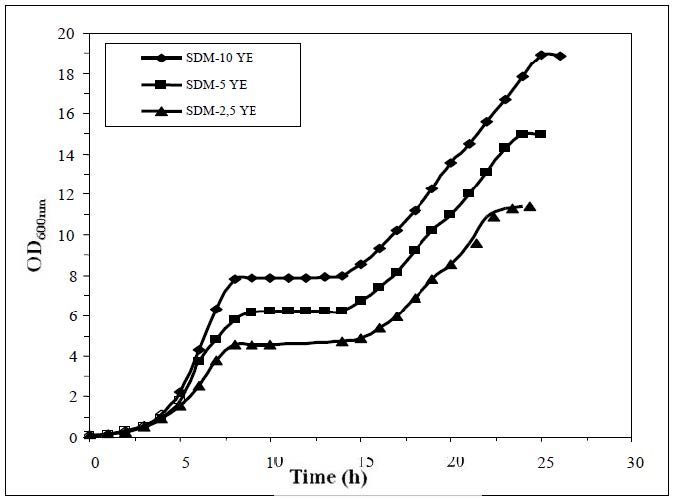
 DownLoad:
DownLoad: 

